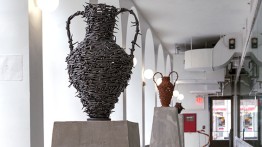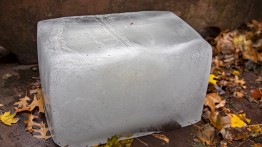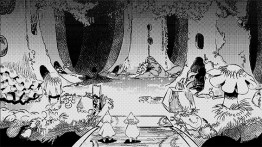Senior Snapshots: Art 2020
POSTED ON: May 21, 2020
At a time when the School of Art is traditionally celebrating their End of Year Show as the culmination of students’ work, these past few weeks have instead for many seniors been about redirecting creative energies. In this final installment of our series profiling members of the Class of 2020, we caught up with Elvin Hu, Paolo Mentasti, and Eric Goins, three art seniors who video-chatted with us about their work, their time at Cooper, and how they have found motivation in the midst of the pandemic.
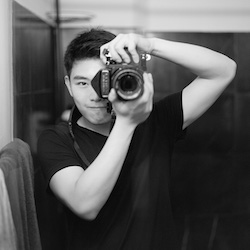 Elvin Hu, for one, might seem better suited than most to working remotely, given that much of his practice these days is digital. But the Sichuan-born designer says he actually planned on doing a photo show for his senior exhibition, a medium he became interested in during his time at Cooper. “Cooper has definitely pushed me to explore other fields of interest,” he says. “Analog photography wasn’t something I had done before. But I began to take medium format and large format photos. I developed stuff in the darkroom and began making prints and photo books. It was a totally new endeavor for me.”
Elvin Hu, for one, might seem better suited than most to working remotely, given that much of his practice these days is digital. But the Sichuan-born designer says he actually planned on doing a photo show for his senior exhibition, a medium he became interested in during his time at Cooper. “Cooper has definitely pushed me to explore other fields of interest,” he says. “Analog photography wasn’t something I had done before. But I began to take medium format and large format photos. I developed stuff in the darkroom and began making prints and photo books. It was a totally new endeavor for me.”
Musical theater is another of Elvin’s many passions. Before Cooper, he moved from Beijing to St. Louis, Missouri to attend Washington University for music and design. Ultimately, he decided New York would better serve his ambitions, so he applied to the School of Art. “I wanted to be close to the heart of the design world,” he explains. Conveniently, New York is also the heart of the theater world. He found time to audition for a few Broadway shows — and even got call-backs for some title roles.
Though Cooper has no theater program, he was fortunate enough to take a course called Theater Collaborative. “We got to experience so many different aspects of theater production. We were acting, designing sets, writing scripts. We did classical Shakespearean stuff, but we also came up with our own stories. That class was a lot of fun.”
The last few years in the School of Art have stretched Elvin’s understanding of his primary discipline as well. “I was mainly exposed to the commercial design world before Cooper. But when I came here, I began learning the history of the discipline and synthesizing different things.” Much of his work in that area could be characterized by its playfulness as much as its serious engagement with how technologies are developed and used. Take for example an app he created last year which grabbed the attention of the Internet for transforming the iPhone into an iPod Classic, complete with iconic click wheel. The project began as a diversion from doing homework while flying to job interviews, but it also provides something of an object lesson for thinking about technological nostalgia, the evolution of interfaces, and the cultural impact of innovation.
“The idea had connections to a class I took called the History of Industrial Design,” he explains. “We had to write about one object, its significance, and different aspects of its design and influence. As a huge Apple nerd, I wanted to research the iPod because people usually only think about its influence on pop culture. But there are other aspects, such as how advancements in the supply chain allowed Apple to make that product at such a low price and pushed manufacturers to innovate.”
Another course Elvin says was formative to his thinking was “Ethics in Design,” taught in Fall 2018 by visiting artist Robyn Kanner. “It’s a class that designers, engineers, anyone working in the field of technology should take because when we work, we don’t always think about the implications for society and people’s daily lives. We tend to project our own way of thinking onto the things we create. In that class we were really pushed to think about the ethical responsibilities that we carry as designers.”
His interest in these broader aspects of design and product development have given him a solid footing as he begins his career. Having interned last summer on Google’s Material Design team, he will be returning to Google for a full-time role as an interaction designer with the company’s Chrome division in California. Though his professional life remains anchored in the digital realm, Elvin hopes to continue doing photography on a personal basis and feels that these various forays into other disciplines have given him a more holistic outlook. “Cooper has really changed my way of thinking. I used to think there was one direction that my life is going, but now I feel more open to possibilities.”
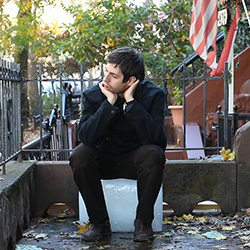 With a penchant for working in messy disciplines and making things by hand, Paolo Mentasti has had to seek out entirely new ways of channeling his creativity while cut off from studio access. Recently, on a run from his apartment to nearby Bush Terminal Piers Park, he got the idea of hanging a mobile in situ, using debris gathered from the ground and a branch that had been caught and left dangling from a wire.
With a penchant for working in messy disciplines and making things by hand, Paolo Mentasti has had to seek out entirely new ways of channeling his creativity while cut off from studio access. Recently, on a run from his apartment to nearby Bush Terminal Piers Park, he got the idea of hanging a mobile in situ, using debris gathered from the ground and a branch that had been caught and left dangling from a wire.
“I was thinking of Alexander Calder’s mobiles as being part of a worldview that wasn’t conscious of climate change,” he explains. “They are models of the universe, but they’re immutable.” Upon returning to the site a few days later, he saw many of the elements tied to his mobile had already fallen off or deteriorated. “I think a lot about the impact that people are having on the planet.”
Both lasting and fleeting impressions have provided a lens through which Paolo’s work looks at the histories of different materials and forms. Ice has been one such recurring element for connecting climate change with issues like migration and colonization. On a research trip to Chennai, India in 2019, for example, he set out to draw together the city’s current struggles over water scarcity with the site of a historic ice house, built in 1842 to store blocks of ice that were imported from New England and sold to colonial elites. A year prior, on the stoop of his apartment, Paolo sat on a block of ice for ten hours, waiting to leave behind an impression as part of a performance he titled “we have one enemy and that is ice.”
“I was using that performance as an irreverent gesture toward what the big white ice block represents,” says Paolo, who was born in Brazil and grew up in Mexico City and Bogota, Colombia. The title was inspired by a speech he heard while working at the New Sanctuary Coalition, where he volunteered to help asylum-seekers with filling out paperwork. The “ice” to which it ambiguously refers is both that of the melting ice caps and the acronym of the federal Immigration and Customs Enforcement agency.
Paolo, who finished his coursework during the Fall 2019 semester, was fortunate enough to show his work in a senior exhibition back in December. “Immigration Forms,” as it was titled, continued this penchant for exploring connective wordplay, formal juxtapositions, and the material history of borders, expansionism, and the environmental pressures that drive migration. “I was thinking of how different forms that remain present or have accumulated on the border, but also about my own immigration process to become a permanent resident here and the frustrations of filling out forms.” Pieces such as “To Bare on Both Sides (Barbed Amphora),” which takes the form of coiled barbed wire in the shape of a vessel, call out the vessel’s intrinsic function of containment, historically used to transport water and goods across borders, as well as the forms used by settlers of the American West to quickly fence off and colonize native lands.
He discovered his love for ceramics during a semester off from his junior year while interning at Greenwich House Pottery, part of a historic settlement house that provides community support, social services, and arts programming in the West Village. Since finishing classes, Paolo began working as a studio technician at Greenwich House and teaching through an afterschool program. Now, with studios closed, he has transitioned to working for the settlement house’s senior services, where he calls seniors from his home to check in on them. He has also been busy putting materials together for the next round of Creative Time’s Emerging Artist Open Call, a biennial public art initiative for which he was just recently shortlisted.
“I proposed to make this sundial sculpture that I had created a model for in my senior show,” he says. “It’s a sundial that would aid immigrants, somebody trying to cross into the United States through the Arizona-Sonora Desert, but it would also serve as a monument that would welcome and embrace them.”
For now, with long-term plans still up in the air, Paolo is counting the days until he can get back in the studio. “This crisis really upended everything and made it hard to focus on making art while being confined to my apartment. The way that I like to work is very hands on. Materials and making are very important to me. Cooper provided me with access to great studio space, great facilities, and really talented and generous technicians, which I was always really grateful for. That’s been one of the things I miss most.”
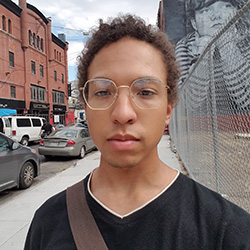 Eric Goins describes the subject matter that most engages his creative work as empathy: “I try to think about empathy a lot of the time from a visual standpoint. How exactly do you identify empathy? What does it look like? If you can identify it, can you teach it?” Much of his work, which includes web comics, illustration, graphic design, and 3D modeling, is oriented in this way toward the communicative power of art. “I view art as a way of understanding other people and also giving myself advice.”
Eric Goins describes the subject matter that most engages his creative work as empathy: “I try to think about empathy a lot of the time from a visual standpoint. How exactly do you identify empathy? What does it look like? If you can identify it, can you teach it?” Much of his work, which includes web comics, illustration, graphic design, and 3D modeling, is oriented in this way toward the communicative power of art. “I view art as a way of understanding other people and also giving myself advice.”
Looking at the emotive subtleties of the characters he creates is one of the ways he poses these larger questions about empathy. His interest in character study also draws inspiration from pop culture and some of his favorite forms of media, such as anime and manga. “If I’m drawing a comic, I try to think very deeply about what that character is going to feel, what another person would feel in that situation, how their facial expression might adjust slightly to that situation.”
This kind of responsive approach to art has been part of Eric’s imagination since his childhood in Virginia Beach. He recalls drawing Dragon Ball Z characters and doing observational sketches at a young age. That early interest in comics and illustration carried him through a high school magnet program in the arts. “I just enjoyed it very early on. I would take art classes every year in school. I had already decided on going to Cooper when I was in 7th Grade.” He explains that he first heard mention of The Cooper Union in the lyrics to the song “Art School” by hip-hop group Das Racist.
“Strangely, the reason I came to Cooper was because I didn’t feel comfortable doing conceptual art,” Eric says. “I wasn't good at conceptual art and I wanted to challenge myself. I didn’t want to just go on ignoring it. I felt like I had an obligation to understand how other people were looking at art and why they were doing it.” Though his practice remains today mainly illustrative, he appreciates the way that the School of Art has allowed him to explore other skills and disciplines. “Coming through Cooper, I’ve been able to slowly drag other things into it. I believe that if I went to a different school purely for illustration, I would have done well but I don’t think I would have branched out as much.”
Adapting to remote learning recently in his final semester has meant looking for a new productive routine more than anything else. “It’s been a wakeup call to what it means to work independently. You need a different mentality to work on something when you’re not going into an office or a studio. I really relied on having a place to get the feeling of working.” Still, he says being at home has given him the chance to re-imagine some things: “The project I did for one design class this past semester was to make promotional work for a show, like posters and postcards. I started before we went remote and had to reformat it, so I did work for my show as if it’s a virtual reality show.”
What comes next for Eric is less certain, but he sounds relatively unworried. “It’s very hard to make plans at the moment. I’m probably going to go farming for a while and then come back. Someplace with mountains. Maybe Wyoming.” He spent last summer working on an organic farm on Long Island through the WWOOF organization. Eventually, he may consider attending graduate school to continue pursuing digital media and motion graphics, mediums that combine different aspects of his various interests. “Motion graphics has been kind of this place where things tie together very well. You kind of get illustration, you get typography, you get motion, you get story planning the same way you do with comics. It’s really the only place where I feel like I can focus without thinking about other mediums I want to do because they’re all already in there.”
In the shorter term, he has plenty to keep himself busy with his practice. “I’m working on a comic at the moment about gnomes. It started with just drawing these gnome characters and then I began asking questions about how they live and drawing the entire landscape they live in. I know I want to keep that project up for as long as I can.”


